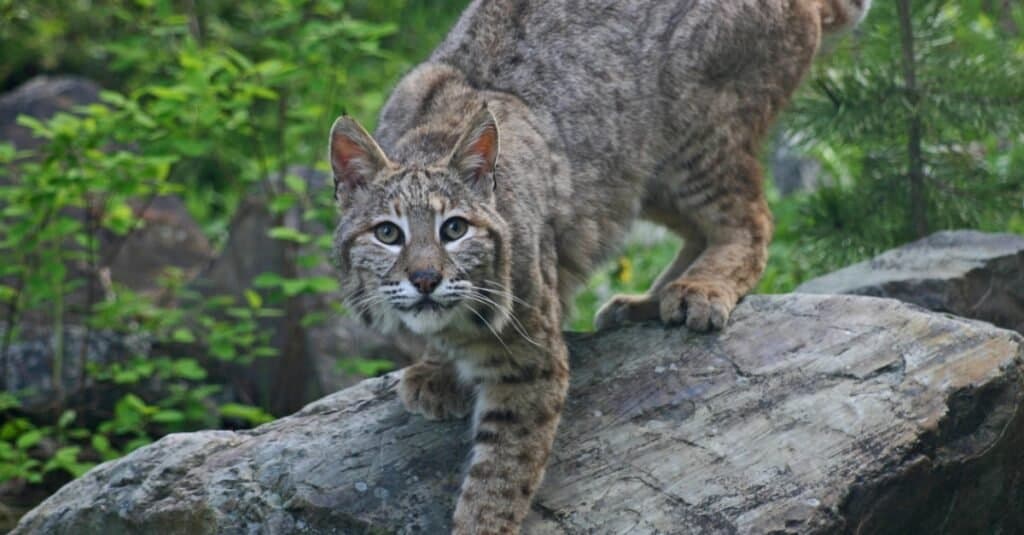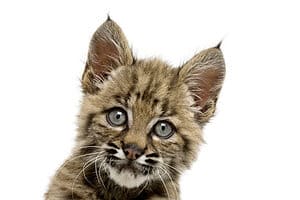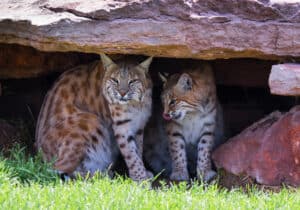Have you recently seen a cute video of a bobcat? Or is there one in your neighborhood that’s caught your attention? Although bobcats are nearly the same size as some domestic cats, they aren’t advertised as pets. Why is this?
Bobcats are wild animals with unique diets, behaviors, and living arrangements. Experts advise against owning or trying to tame a bobcat. But is it possible to keep a bobcat as a pet? Keep reading to find out and learn more about these cute, but wild medium-sized cats.
About Bobcats
Bobcats are medium-sized North American cats living in some parts of Canada, Mexico, and the United States. They are quiet animals that stay away from humans; however, you can sometimes spot them lingering in suburbs.
Size and Appearance

A bobcat’s face looks wide due to its fluffy fur that extends past its ears.
©Victor Arita/Shutterstock.com
Bobcats generally have tan to grayish-brown coats with black spots or streaks. However, their coats vary. They are also best known for their long and pointed ears and short bobbed tails. The tips of their ears are black. A bobcat’s face looks wide due to its fluffy fur that extends past its ears. Bobcat faces stand out because they have off-white fur on the chin, lips, and underside. Interestingly, their coat’s shade depends on where they live, since it acts as camouflage. For example, bobcats in the southwest have light coats, while those living in northern heavily forested regions have the darkest coats. Although not as common, some bobcats are born fully black, with some spots.
Adult bobcats aren’t very big. On average, an adult bobcat is about 18.7 to 49.2 inches long. Its tail is only about 3.5 to 7.9 inches long. Adult bobcats stand 1 to 2 feet tall. Females are slightly smaller than males, but it’s most noticeable in their weight. Females weigh about 15 pounds, but they can weigh anywhere between 8.8 to 33.7 pounds. Males, on the other hand, weigh approximately 21 pounds. However, they can weigh anywhere between 14 to 40 pounds. The largest confirmed bobcat weighed 49 pounds, but some people have reported (unofficially) weights up to 60 pounds.
Diet
Bobcats are hunters; however, they can survive long periods without food or water when certain conditions arise. When prey is abundant, bobcats eat a lot, which helps them when there isn’t enough food, specifically in winter. Bobcats mainly hunt mammals ranging from 1.5 to 12.5 pounds. They take down larger mammals and feed on them slowly. What this animal eats depends on the region. Most bobcats in the eastern U.S. hunt for eastern cottontails, while those in the north consume snowshoe hares. Bobcats are opportunistic predators, sometimes ambushing nesting birds and eggs. These medium-sized cats are great hunters and sneak attack their prey.
Predators
It’s more common for baby bobcats, also known as kittens, to fall vulnerable to predators. For example, bears, coyotes, eagles, and great horned owls often hunt young bobcats. Adult bobcats have few if any natural predators. However, experts have documented attacks between adult bobcats and cougars, and gray wolves. These encounters are especially common in Yellowstone National Park. Most bobcats die because of old age, hunting, accidents, starvation, and diseases.
Are Bobcats Friendly to Humans?

These medium-sized cats rarely interact with humans, but when they do, they retreat quickly.
©Rejean Bedard/Shutterstock.com
Bobcats are shy and avoid people. There’s never been an official or documented fatal bobcat attack on a human. Instead, humans are the largest threat to bobcats. These medium-sized cats rarely interact with humans, but when they do, they retreat quickly. However, this doesn’t mean you should ever try to harass, touch, or interact with a bobcat. Mother bobcats are aggressive and will defend their young. Some bobcats also carry rabies.
Can Bobcats Be Pets?
Bobcats are an adorable sight to see in the wild, although rarely seen. Wild bobcats don’t make great pets; however, a few states allow the possession of a bobcat with the proper licenses and permits. That being said, you should never take a bobcat from the wild and introduce it to your home! Although bobcat kittens are tame and calm, they are still wild animals. Bobcats need a lot of space, and the average house is too small. Bobcats aren’t like domestic house cats. They are quite expensive and require a specialized diet high in protein. It’s not enough to purchase dry cat food from the grocery store!
Although bobcats should not be owned as pets, some states allow it. To own a bobcat in states like Arizona, Florida, Texas, Indiana, Maine, Pennsylvania, Rhode Island, Oklahoma, Missouri, Mississippi, North Dakota, South Dakota, and Delaware, you need a permit or registration. But keep in mind, there are restrictions in all these states. In some states, it is completely illegal to own a bobcat, including in Utah, Virginia, New York, New Jersey, and Maryland.
Bonus: Do Bobcats Prey on Pets?

Bobcats will eat anything they can bring down – including small pets.
©iStock.com/Anita Elder Design
With all of the discussion of whether bobcats make good pets you may forget that they will prey on pets if given the chance! While attacks on pets aren’t common they are increasing in frequency as humans continue to encroach on their native habitats. Bobcats are highly adaptive – which is a major reason for their success as a species. If people move into their territory – they will adapt – perhaps finding small dogs and domestic cats to be easy new prey.
Small dogs left in fenced backyards are easy game for these agile predators. They can jump or climb a fence with minimal effort and are powerful animals. Pet cats that roam outside would also be easy targets for experienced hunters. Farm animals like goats and chickens are also at risk. If you suspect that a bobcat is in your neighborhood – keep your cats inside and don’t leave small dogs outside by themselves. Goats and chickens can be protected by trained guard dogs.
The photo featured at the top of this post is © Vaclav Sebek/Shutterstock.com
Thank you for reading! Have some feedback for us? Contact the AZ Animals editorial team.






